Plenty of complaints have been registered in the last few days for one of the prominent blue screen issues on Windows 10 namely DRIVER VERIFIER IOMANAGER VIOLATION. From the origin, it is a BSOD error and nowadays pretty common with the users. With an effect, you can see an abnormal blue flashing on the screen which the company said to cause devastating damage. The error has a bug check value of 0x000000C9 and it needs an immediate resolution.
The majority of the Blue Screen errors like DRIVER VERIFIER IOMANAGER VIOLATION occurs due to the system having outdated and incompatible drivers. Besides, missing system resources because of malware attack or conflict between similar programs are equally responsible for causing the same. When the bug cause vulnerability in the system, computer freezes randomly making it inaccessible. Working along becomes too tough as the functionality drops down for a slow operation. Nowadays, the error has become so threatening that we have to take necessary actions before it’s too late. We will discuss all the possible resolutions to eliminate this risk in the following segment. Here are the jump links to resolution processes and resources discussed in the article –
DRIVER VERIFIER IOMANAGER VIOLATION Error in Windows 10 Solutions
Here is how to fix DRIVER VERIFIER IOMANAGER VIOLATION Error in Windows 10 –
1] Install all available patches
Operating System needs to be updated every time to keep pace with modern features. As to facilitate this process, Microsoft releases cumulative updates quite regularly. These files have to address bugs inside as well. An outdated OS is very much prone to be affected by DRIVER VERIFIER IOMANAGER VIOLATION Error. Therefore, we need to install the update patches when available.
Important – Manage to get connected with a speedy internet connection to reduce time consumption while downloading. Also, remember to disable the Metered Connection if you are using Mobile Hotspot.
- Open Windows Settings, the built-in app by pressing Win + I hotkeys together.
- While in the app area, click Update & Security tile.
- Windows Update page shows up, switch to the right pane. Click Check for updates button.
- When all the patches are available here, hit the Download button to get the update files in the system.
- Upon finishing the process, the installation will start automatically.
- Restart the Windows when asked to complete the installation process.
2] Run System File Checker to Resolve DRIVER VERIFIER IOMANAGER VIOLATION
Operating system with missing DLL files and corrupted resources is very much likely to suffer from DRIVER VERIFIER IOMANAGER VIOLATION Error. We can rectify these components using a simple tool named System File Checker. The tool will only be effective in an Elevated Command Prompt. Follow the below guidelines to complete the task –
- Press Win+S together and let Taskbar Search appear.
- Write cmd.exe in the empty typing space given here.
- When the results are loaded, do a right-click on Command Prompt and select Run as Administrator.
- Choose Yes to give consent once UAC prompts for permission.
- When you are already in the prompt window, copy the following text and enter are the blinking cursor –
- Now, press the Enter key to power up the System File Checker and wait for a while.
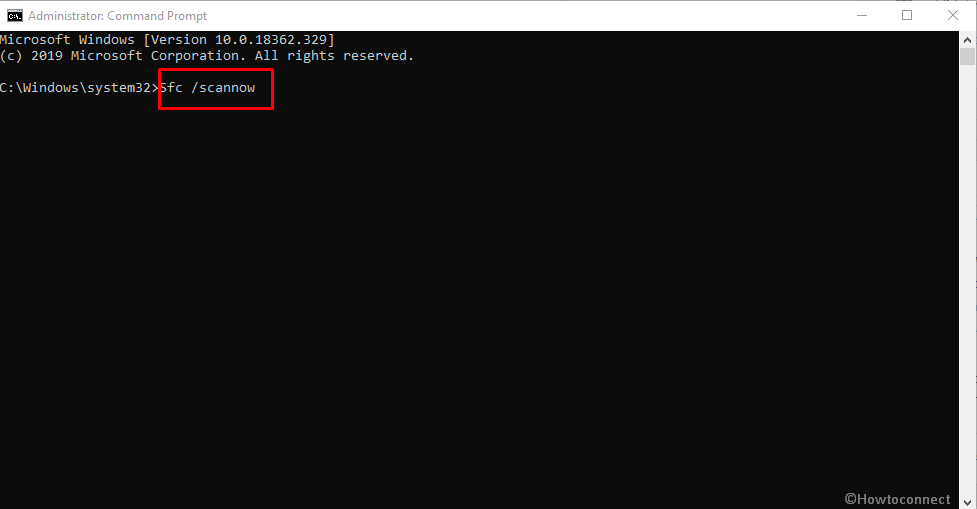
- Upon finishing, Restart the device and later on, check if there is an error in the system.
3] Use Windows Security to dismiss malware
Whenever malware enters the system, it deletes the necessary OS components. Some of the important DLL files go missing for them as well which ultimately results in DRIVER VERIFIER IOMANAGER VIOLATION Error. To remove these bugs easily, you can use Windows Security in Windows 10. Let’s make the use of this tool and dismiss them internally –
- Press Win+S hotkeys and let Taskbar search appear.
- Type Security in the search field and press Enter.
- Once the Windows Security app arrives, select option Virus & threat protection.
- From the visible window, click on the Scan options link.
- Choose the round radio button for Full scan and then “Scan now” to initiate the process.
- Select the Clean threats option if the application traces out any possible virus in the system.
- Hit Remove and later on Start actions button to remove them completely.

4] Update all the outdated Drivers to fix DRIVER VERIFIER IOMANAGER VIOLATION
Drivers are an integral component of the operating system and they also cause BSOD error when found to be outdated. Updating them is the best workaround for maintaining Windows in good condition. Usually, in Windows 10, all these drivers are updated automatically but sometimes it might miss out and cause DRIVER VERIFIER IOMANAGER VIOLATION Error eventually. The Device Manager comes in the first place when we consider updating them. On this platform, these drivers are usually shown with a warning sign facilitating the task a lot. This will be easier to understand who is playing a big role in causing the error. Give the solution a try following below steps –
- Invoke the Run dialog pressing Win+R hotkey together.
- Type devmgmt.msc in the provided text box here and press Enter.
- After the console shows up, have a close look for any Exclamation mark in it.
- If there is any, select that it and expand the driver list eventually.
- Do a right-click on the driver and select Update driver option.
- Make the same for all drivers and once the process comes to an end, restart Windows to implement the changes.
- After restarting, check if there is any BSOD error in the system.
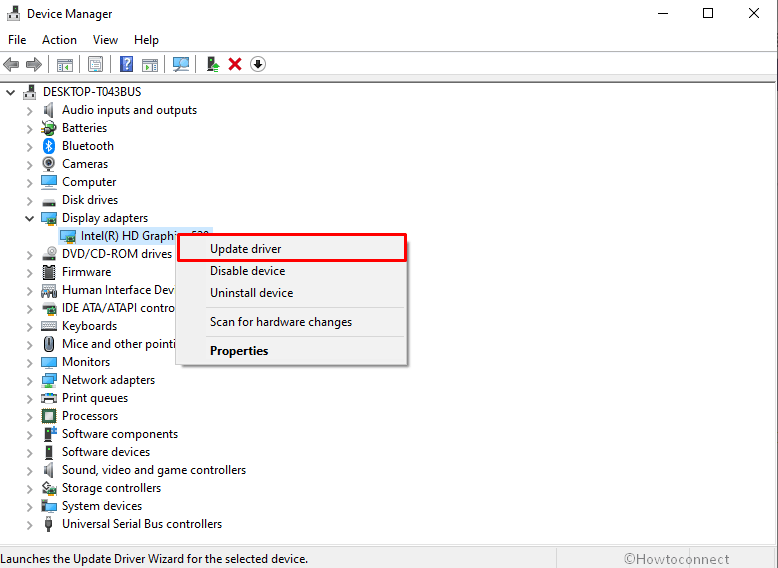
5] Use the DISM tool
Windows image files, in many cases, become damaged and cause DRIVER VERIFIER IOMANAGER VIOLATION error in Windows 10. However, we need to fix these files immediately and for that, the DISM tool can be helpful. Since the utility executes in Elevated Command Prompt, therefore, we need to launch it first. Here are the complete guidelines –
- Open the Run dialog box and to do so, press “Win+R” hotkeys together.
- In the text box provided here, type cmd.
- Use the combination of Ctrl + Shift + Enter keys to load Elevated Command Prompt directly.
- If UAC prompts on the screen, click on the Yes button.
- Once it opens, type following command tool –
DISM.exe /Online /Cleanup-image /Restorehealth
- Press Enter key to activate the DISM tool.
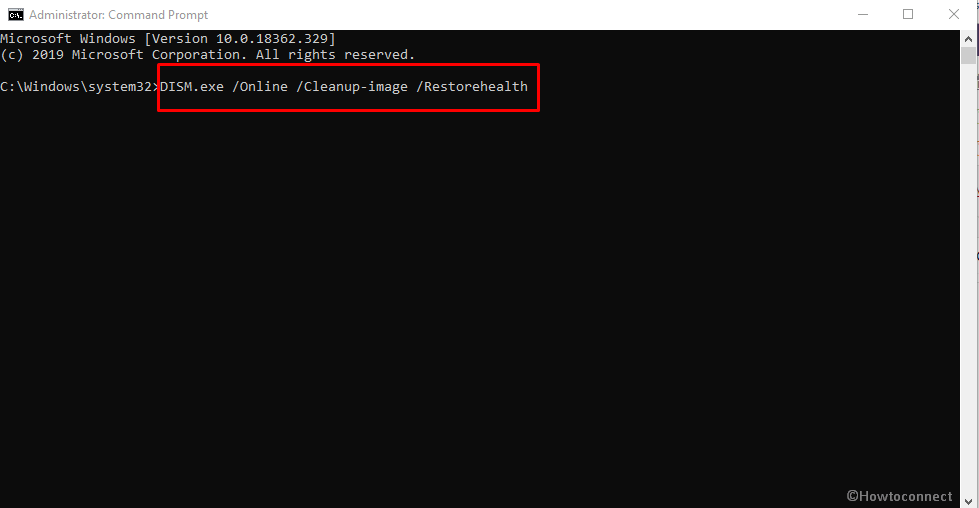
- All the defective image files will be detected and fixed automatically. It might slightly be a time taking process, hold the patience until it finishes.
- To make this resolution effective, reboot the device.
6] Disable Automatic Reboot
Once a device is detected to be affected with DRIVER VERIFIER IOMANAGER VIOLATION Error in Windows 10, the system intends to reboot automatically without prior notice. This will make things worse as you cannot do an important task smoothly on the PC. Even while trying to resolve the issue, there is no enough room to deploy the workarounds. Hence, considering this with the highest priority, we need to disable the action immediately. Tweaking the default setting a little will be enough for that. Move out with the below method –
- First of all, save and close if you are running any ongoing processes and then press Win+D keys at once to load the Desktop area directly.
- Right-click on the This PC icon and choose Properties option.
- When the System window comes in, select ‘Advanced system settings‘ from the left pane.
- After a new popup appears namely System Properties; you will be taken to the Advanced tab.
- In this tab, click Settings located under the Startup and Recovery section.
- On the subsequent page, visit the System failure section.
- Here, remove the mark before the Automatically restart choice.
- Save these changes to the Windows by clicking the OK button.

After changes being effective, Windows will not prompt to reboot all of a sudden. Thus, there will be an abundant scope for expanding the rest of the resolutions.
7] Use Windows Blue Screen Troubleshooter
Stop errors are noted to perform severe losses to the device and sometimes damaging it completely resulting in DRIVER VERIFIER IOMANAGER VIOLATION. Considering this point, the company came up with a default utility which is a preferable solution for this issue. They introduced an application in the name of Windows Blue Screen Troubleshooter and it becomes the most influential relief ever. To have this utility, you need to upgrade the OS to Windows 10 Fall Creators Update version or above. Afterward, follow the below guidelines and apply the tool –
- Open the Windows Settings app pressing Win + I together.
- From the appearing Homepage, select Update & Security to load its more settings.
- From the succeeding page, select Troubleshoot lying on the left pane.
- Go to the right and find out the Blue Screen option.
- Do a click on the option and hit the Run the Troubleshooter button.
8] Repair Memory Problems to fix DRIVER VERIFIER IOMANAGER VIOLATION
When the Random Access Memory (RAM) has poor segments in it, BSOD DRIVER VERIFIER IOMANAGER VIOLATION errors promote up. Because of the wrong allocation of memory, this issue also arises in the device. To avoid these circumstances, we need to settle these issues immediately using Windows Memory Diagnostic tool. Let’s proceed –
- Invoke Taskbar Search pressing Win+S hotkeys.
- When the Search opens, type “Memory” in the empty space.
- Select Windows Memory Diagnostic once it appears in the list.
- When it opens, click on “Restart now and check for problems (recommended)”.
- Windows complete the first cycle of the rebooting process in a moment.
- Once it powers up, you will come across a blue screen detecting memory issues.
- When the progress hits 100%, the OS will reboot for the second time.
- After completing the process, you can check the result of the diagnosis in the Notification area of the System Tray.
9] Make space out of Disk Storage
For the execution of tasks, the device produces a good number of unnecessary files every day. They usually keep on saving in the Disk space but when it gets stored in large quantities, they occupy huge space in the storage. In the meantime, if you feel that the Disk Space running low and operational speed is affected then there is a chance to have DRIVER VERIFIER IOMANAGER VIOLATION Error. To clean up these unnecessary files, Disk Cleanup Utility comes handy. To deploy the tool, instructions are as following –
- Press Win+X menu and select Run from the Power-user menu.
- In the search box provided here, type cleanmgr and press Enter.
- Choose C: by clicking on the dropdown menu and hit Enter key.
- In a moment, the Disk Cleanup application will appear after making the calculation.
- When a wizard opens, hit the Clean up system files button.
- Once the tool prompts to pick the drive again, select C: and press Enter key.
- In the Disk Cleanup for (C:) popup once appears, move on to Files to delete the section.
- Now, check all boxes available here except Downloads.
- Hit the OK button and let the process start.

Important – Perform a check in the Recycle Bin before deleting all the files. This will save you from losing necessary items unwillingly.
10] Disconnect External Hard Drive temporarily
According to several users, they have experienced DRIVER VERIFIER IOMANAGER VIOLATION Error just after connecting an additional Hard Drive to the system. This report brought disquietness all around as we know how important such drivers are. However, the good news is that we can fix the issue easily only by disconnecting hard drive temporarily.
- Before proceeding this, make sure to carry out the task with care to avoid damaging anything.
- Now, detach the drive and Restart your Windows 10 PC.
- Upon returning to operation, check for error again.
- If nothing comes up, you can connect the device again.
- For more stability, download and install its latest driver from the official website going through a browser.
11] Uninstall similar applications to fix DRIVER VERIFIER IOMANAGER VIOLATION
Similar applications in a system cause a collision often in between them. The result is quite critical and they remove the essential OS components from the System. Missing files from Windows may cause DRIVER_VERIFIER_IOMANAGER_VIOLATION errors, so there’s the need to restrict those programs from a collision. The only way out is to remove one of these by uninstalling. Here is how to proceed –
- Right-click on the Start menu and select Apps and Features option.
- By default, you will be guided to the Apps Settings page.
- Move to the right side pane and find programs with similar functionality.
- Select each and choose the Uninstall button located in the expanded pane and follow the on-screen instructions.
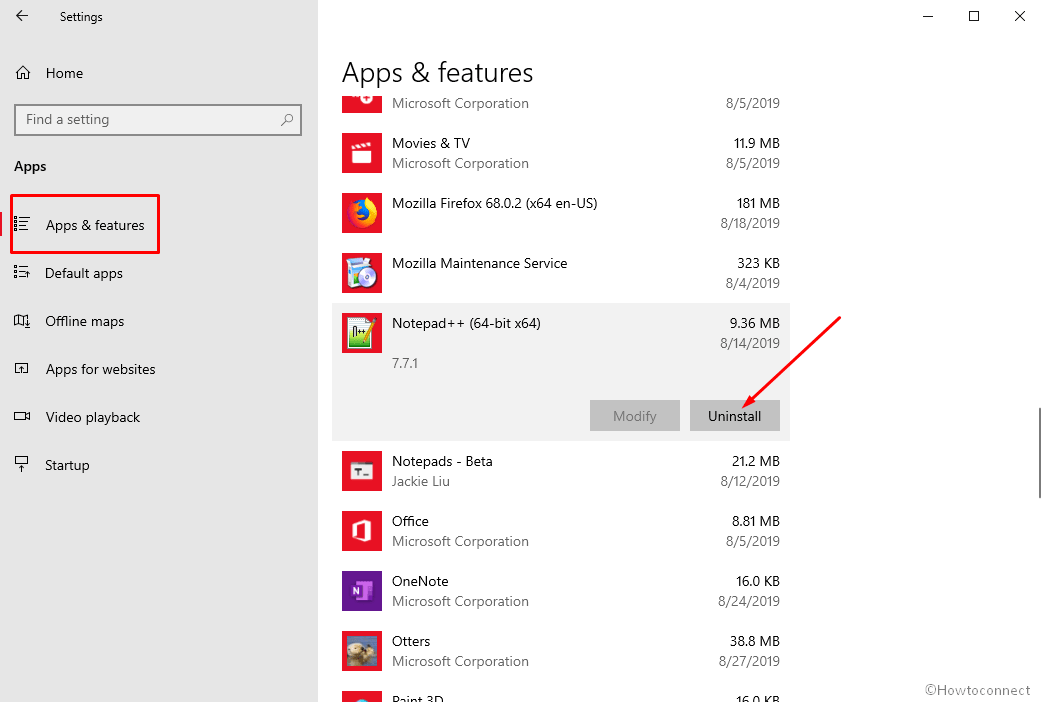
- Restart Windows once and after signing back in, check for BSOD error in the system.
- If no issues found in it, you can download and install these programs once necessary.
12] Uninstall buggy Windows Update
To maintain the OS in good condition, we need to install updates patches once available. Microsoft has made the whole Windows updating system autonomous to facilitate users. When this system terminates abnormally, there is a chance of having DRIVER VERIFIER IOMANAGER VIOLATION Error. You can easily reduce the chance by uninstalling these files. The guidelines are as follows –
- Open the Settings app using Win+I altogether.
- From the appearing app area, select Update & Security.
- On the following page, do a click on the View update history link.
- Select the Uninstall updates link. The action will load the Installed Updates immediately in a separate window.
- In the current page, reach out to the latest patch you have installed.
- Do a right-click on it and choose the Uninstall option once visible.
- Follow the on-screen guidelines until you get rid of them finally.
13] Perform System restore to resolve DRIVER VERIFIER IOMANAGER VIOLATION
Installing a new program to a device or uninstalling existing modify Windows Registry. If you are getting DRIVER VERIFIER IOMANAGER VIOLATION Error after such changes mean, there is something wrong here. Well, we can skip having a BSOD issue by performing System Restore. It’s a simple technique to head back to the previous point. User must have a previously created Restore points to use this workaround. Unless you have one, skip the process here and move for the others. Fortunately, if your Windows have such points, move with below instructions –
- Open the Taskbar Search by making a press of Win+S hotkeys.
- Type rstrui in the empty field and then press the Enter key.
- Choose the Next button to proceed ahead.
- Make a click on Show more points option when the next page comes in.
- From the list make a click on the latest one and hit the Next button once again.
- After the succeeding page loads, select Finish and let the utility start restoring.
14] Remove Third-party Anti-virus programs
In the past, the user used to access third-party antivirus programs for dealing with malware. But coming to this time, Windows Security has become the best ever utility in this case. Typically, other third-party anti-malware programs are really ineffective and they can even take part in causing DRIVER VERIFIER IOMANAGER VIOLATION Error. Therefore, we prefer to remove this program to get rid of Stop errors. To complete the task, instructions are as following –
- Do a right-click on the Start menu and choose Run to open.
- In the small pop-up menu, type appwiz.cpl and click on the OK button.
- This will unroll Programs and Features window in the display.
- Locate the third-party antivirus applications in the appearing list.
- Select it and then click on the Uninstall option from the top ribbon.
- Once UAC asks permission, hit Yes to proceed.
- Follow the further guidelines until this app uninstalls successfully.
15] Settle down Hard Disk Bad sector
After using the same Hard Disk for a long time, bad regions might form in it and as a result, DRIVER VERIFIER IOMANAGER VIOLATION Error evolves. However, you are able to fix this mess easily using the Disk Checking tool. First of all, you need to enter into Elevated Command Prompt to execute the utility and then move with the below guidelines –
- Press Ctrl + Alt + Del keys at once and choose Task Manager from appearing window.
- When in the app UI, select the File option located at the top left corner.
- Choose Run a new task option from the appearing menu.
- Once a dialog comes into view, enter “cmd” text in its typing box.
- Scroll and put checkmark before “Create this task with administrative privileges”.
- Now, press Enter key to launch Elevated Command Prompt directly.
- Once it opens, type the following URL near the cursor –
chkdsk C: /f /r /x
- Press the Enter key and let Disk Checking Tool activate.
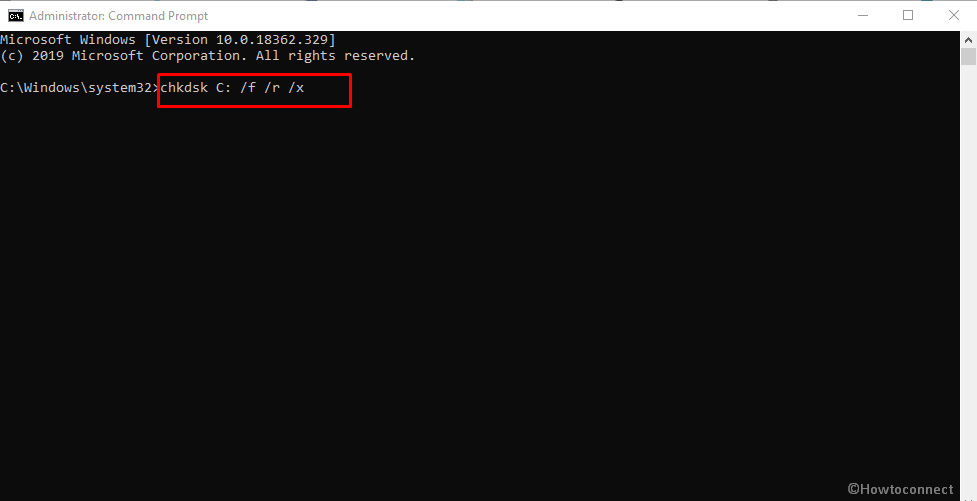
- Wait for a while until it finishes and then restart the device.
- Once return back, check if there is any BSOD error available.
16] Boot the device in Safe Mode to fix DRIVER VERIFIER IOMANAGER VIOLATION
From the very beginning, Windows used to gets affected by bugs and problems right after starting its journey as Operating System. It was a little bit unstable and indulged in issues but at the same time, booting in Safe Mode came out as resolution. In this special Startup method, Windows load only basic programs that in last improve the DRIVER VERIFIER IOMANAGER VIOLATION Blue Screen Error. We will now give a try to Boot into Safe Mode. Here are the guidelines –
- Click on the Start Menu and select the Power icon.
- Choose Restart holding Shift key at the same time.
- When Windows starts the booting process, you will come across an Advanced Blue screen showing few options.
- Make a click on the Troubleshoot option and load the next screen.
- On this page, select Advanced Options followed by a hit on “Startup Settings”.
- Now, click on the Power icon and choose Restart option and let the Windows to reboot for the second time.
- When the next Startup screen arrives, you will see a set of options including one to Enable Safe Mode.
- From here, press the F4 button to enter into the Safe Mode.
Hereby, we have discussed all the possible workarounds that can potentially eliminate DRIVER VERIFIER IOMANAGER VIOLATION Error BSOD in Windows 10. These are proven resolution processes and should work for your case as well. Unfortunately, if nothing comes in your way, don’t lose hope as you can still recover the PC by performing the Clean Reinstallation of Windows 10.
Before starting to perform the workaround, save a backup for the necessary files first. Connect the device with speedy internet for downloading content at a faster rate. Try seeking help from skilled professionals if you are not confident enough.
Methods:
1] Install all available patches
2] Run System File Checker
3] Use Windows Security to dismiss malware
4] Update all the outdated Drivers
5] Use the DISM tool
6] Disable Automatic Reboot
7] Use Windows Blue Screen Troubleshooter
8] Repair Memory Problems
9] Make space out of Disk Storage
10] Disconnect External Hard Drive temporarily
11] Uninstall similar applications
12] Uninstall buggy Windows Update
13] Perform System restore
14] Remove Third-party Anti-virus programs
15] Settle down Hard Disk Bad sector
16] Boot the device in Safe Mode
That’s all!!
